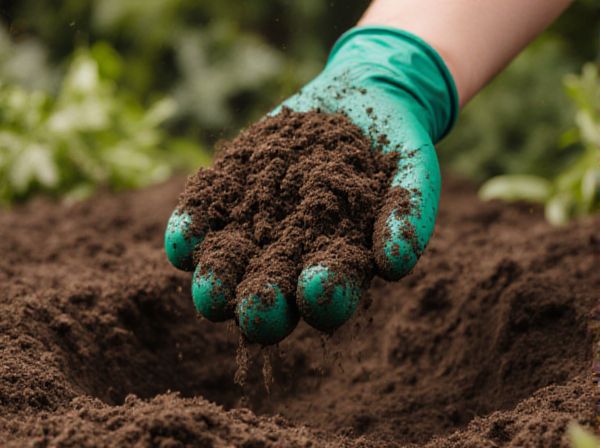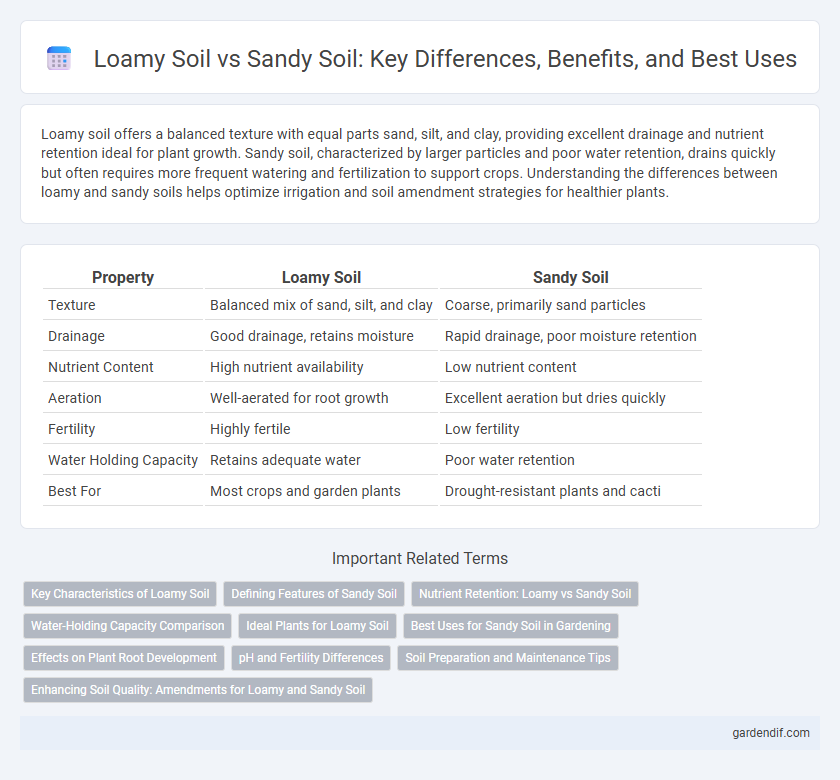
Loamy soil vs Sandy soil Illustration
Loamy soil offers a balanced texture with equal parts sand, silt, and clay, providing excellent drainage and nutrient retention ideal for plant growth. Sandy soil, characterized by larger particles and poor water retention, drains quickly but often requires more frequent watering and fertilization to support crops. Understanding the differences between loamy and sandy soils helps optimize irrigation and soil amendment strategies for healthier plants.
Table of Comparison
| Property | Loamy Soil | Sandy Soil |
|---|---|---|
| Texture | Balanced mix of sand, silt, and clay | Coarse, primarily sand particles |
| Drainage | Good drainage, retains moisture | Rapid drainage, poor moisture retention |
| Nutrient Content | High nutrient availability | Low nutrient content |
| Aeration | Well-aerated for root growth | Excellent aeration but dries quickly |
| Fertility | Highly fertile | Low fertility |
| Water Holding Capacity | Retains adequate water | Poor water retention |
| Best For | Most crops and garden plants | Drought-resistant plants and cacti |
Key Characteristics of Loamy Soil
Loamy soil boasts a balanced mixture of sand, silt, and clay, offering ideal texture and nutrient retention for plant growth. Its high organic matter content enhances moisture retention while ensuring excellent drainage and aeration. This soil type supports robust root development and is favored for agriculture due to its fertility and ease of cultivation.
Defining Features of Sandy Soil
Sandy soil is characterized by its large, coarse particles that create excellent drainage and aeration but poor nutrient retention. Its low clay and organic matter content make it prone to rapid drying and nutrient leaching. This soil type supports drought-resistant plants but requires frequent watering and fertilization for optimal growth.
Nutrient Retention: Loamy vs Sandy Soil
Loamy soil excels in nutrient retention due to its balanced composition of sand, silt, and clay, providing optimal conditions for plant growth. Sandy soil, characterized by large particles and low organic matter, drains nutrients quickly, making it less efficient at holding essential minerals. The superior nutrient retention of loamy soil enhances fertility and supports sustained agricultural productivity compared to sandy soil.
Water-Holding Capacity Comparison
Loamy soil exhibits superior water-holding capacity compared to sandy soil due to its balanced mixture of sand, silt, and clay particles, which enhances moisture retention and nutrient availability. In contrast, sandy soil's larger particles create larger pore spaces, leading to rapid drainage and reduced water retention, making it less ideal for water-dependent crops. Efficient irrigation practices and organic matter incorporation can improve sandy soil's water-holding ability, but loamy soil remains the preferred choice for optimal water management in agriculture.
Ideal Plants for Loamy Soil
Loamy soil, characterized by balanced proportions of sand, silt, and clay, offers excellent drainage and nutrient retention, making it ideal for growing vegetables like tomatoes, carrots, and beans. Its fertile texture supports a wide variety of plants including flowering shrubs such as rhododendrons and azaleas. Unlike sandy soil, which dries quickly and supports drought-tolerant plants, loamy soil sustains moisture, promoting healthy root development in many garden plants.
Best Uses for Sandy Soil in Gardening
Sandy soil, characterized by large particle sizes and excellent drainage, is ideal for plants requiring well-aerated root zones such as cacti, succulents, and Mediterranean herbs like rosemary and thyme. Its quick drying nature prevents root rot, making it perfect for crops sensitive to waterlogging, including carrots and radishes. Gardeners can improve sandy soil fertility by incorporating organic matter to enhance nutrient retention without compromising its drainage capacity.
Effects on Plant Root Development
Loamy soil, composed of balanced proportions of sand, silt, and clay, provides optimal aeration, drainage, and nutrient retention, fostering extensive and healthy plant root systems. Sandy soil, characterized by large particles and high porosity, drains quickly but often lacks sufficient nutrients and moisture, leading to shallow root growth and reduced plant stability. Roots in loamy soil benefit from enhanced oxygen availability and moisture consistency, promoting robust development compared to the limited root expansion observed in sandy soil environments.
pH and Fertility Differences
Loamy soil typically has a balanced pH ranging from 6.0 to 7.0, which supports optimal nutrient availability and high fertility, making it ideal for most crops. Sandy soil tends to be more acidic with a pH between 5.0 and 6.0 and has lower fertility due to poor nutrient retention and rapid drainage. The higher organic matter content in loamy soil enhances nutrient-holding capacity compared to sandy soil, which requires frequent fertilization to maintain plant growth.
Soil Preparation and Maintenance Tips
Loamy soil requires less frequent watering and benefits from regular addition of organic matter like compost to maintain its balanced texture and nutrient content. Sandy soil demands more consistent moisture retention strategies, such as incorporating peat moss or coconut coir, and mulching to reduce water evaporation and nutrient leaching. Both soil types should be periodically tested for pH levels and nutrient deficiencies to optimize plant growth and soil health.
Enhancing Soil Quality: Amendments for Loamy and Sandy Soil
Loamy soil benefits from organic amendments such as compost and well-rotted manure, which improve nutrient retention and water-holding capacity, enhancing soil structure and fertility. Sandy soil requires the addition of organic matter like peat moss, biochar, or coconut coir to increase moisture retention and nutrient availability, preventing rapid drainage and nutrient leaching. Incorporating clay particles or using cover crops can further stabilize sandy soil texture, promoting better root growth and overall soil health.
Loamy soil vs Sandy soil Infographic

 gardendif.com
gardendif.com